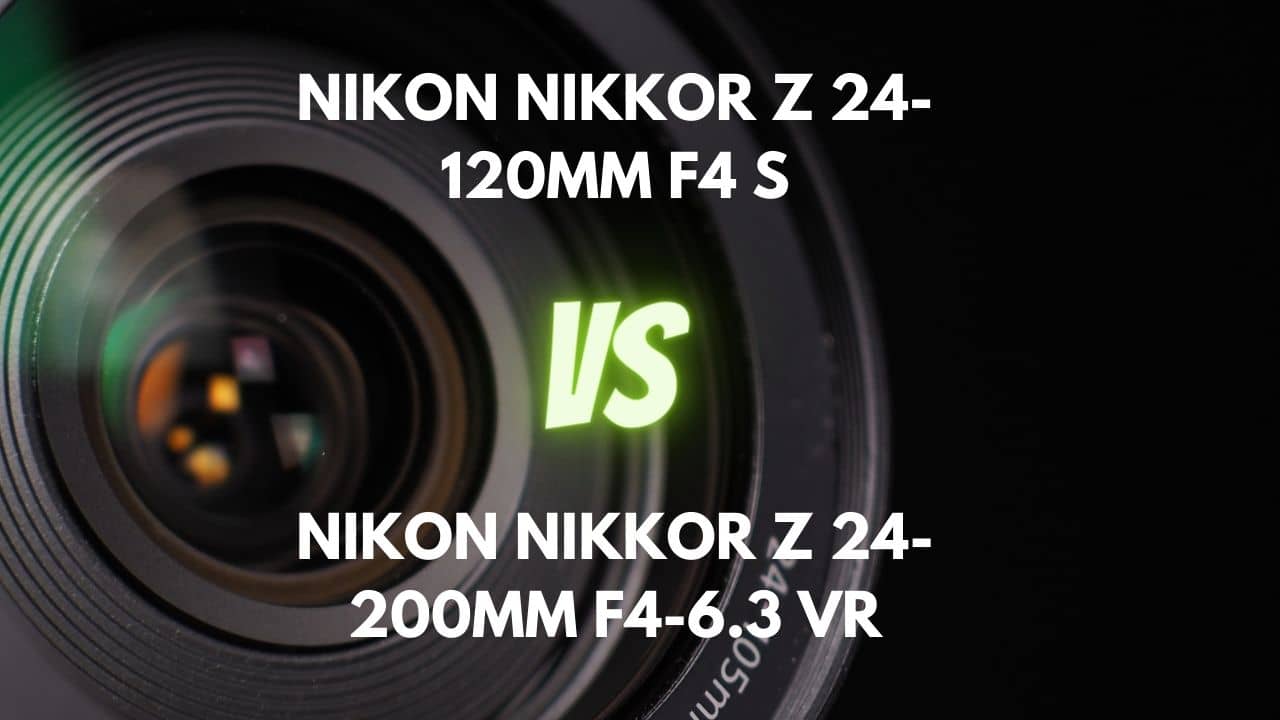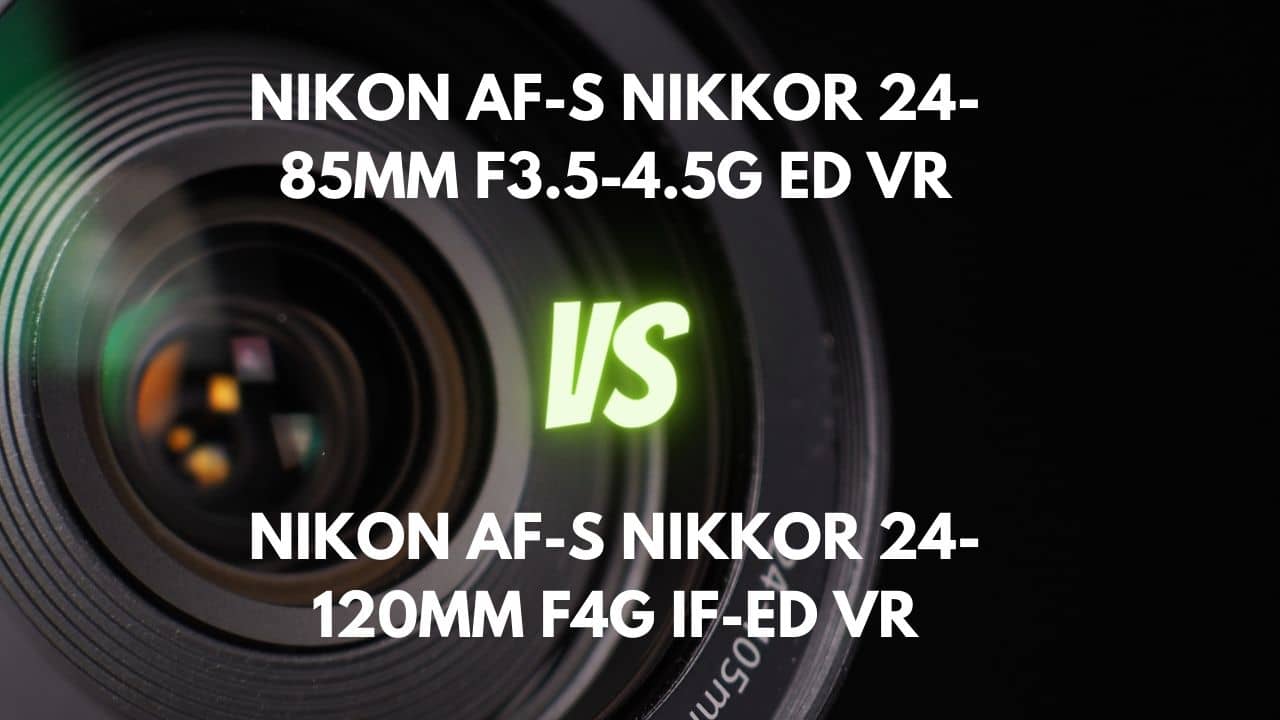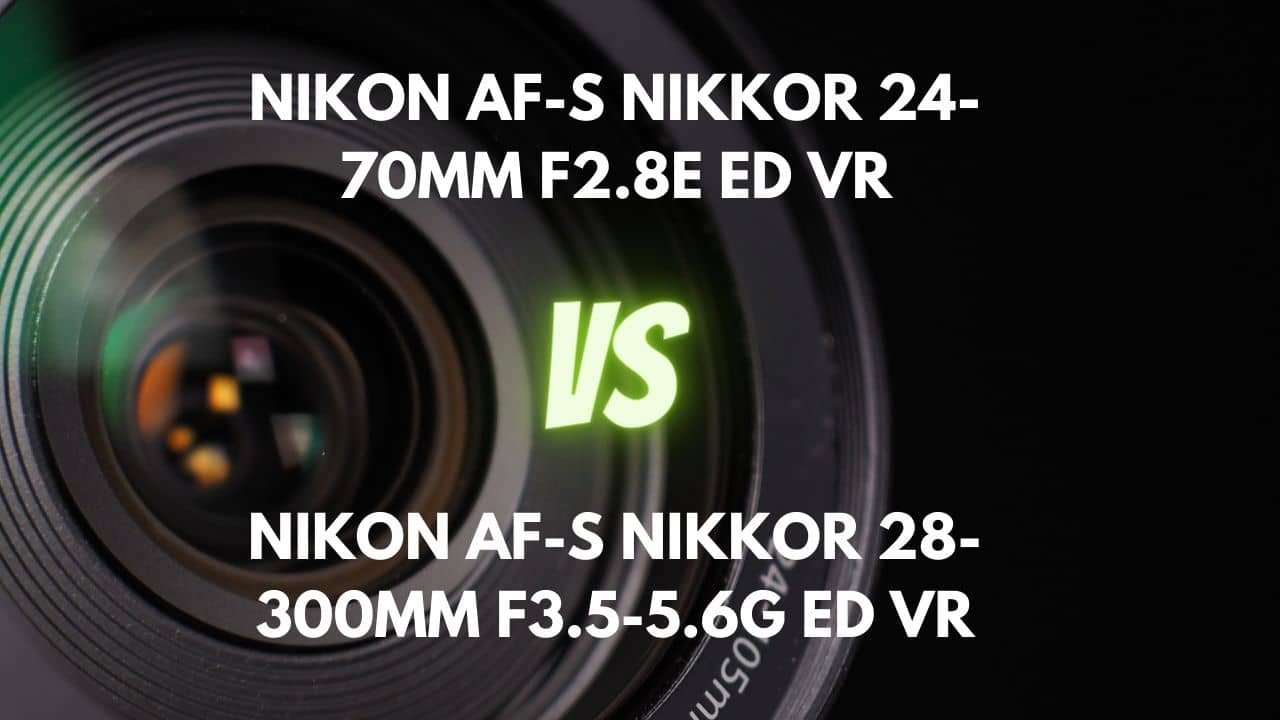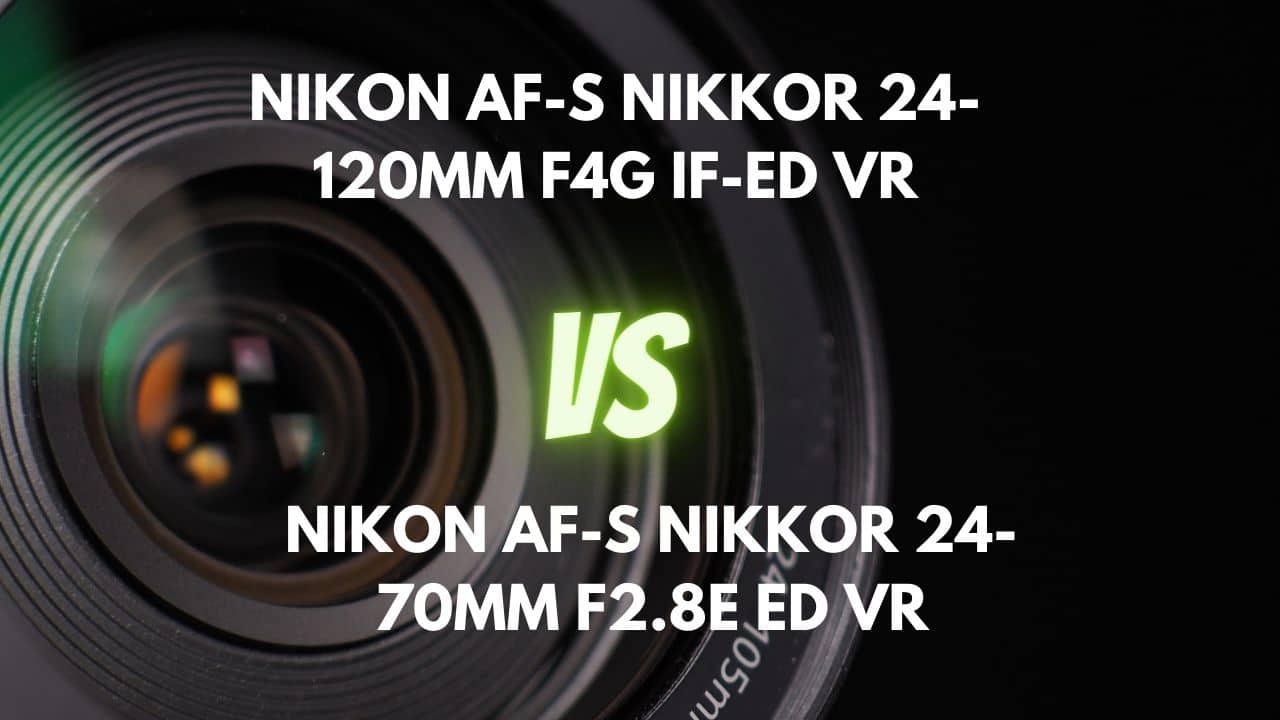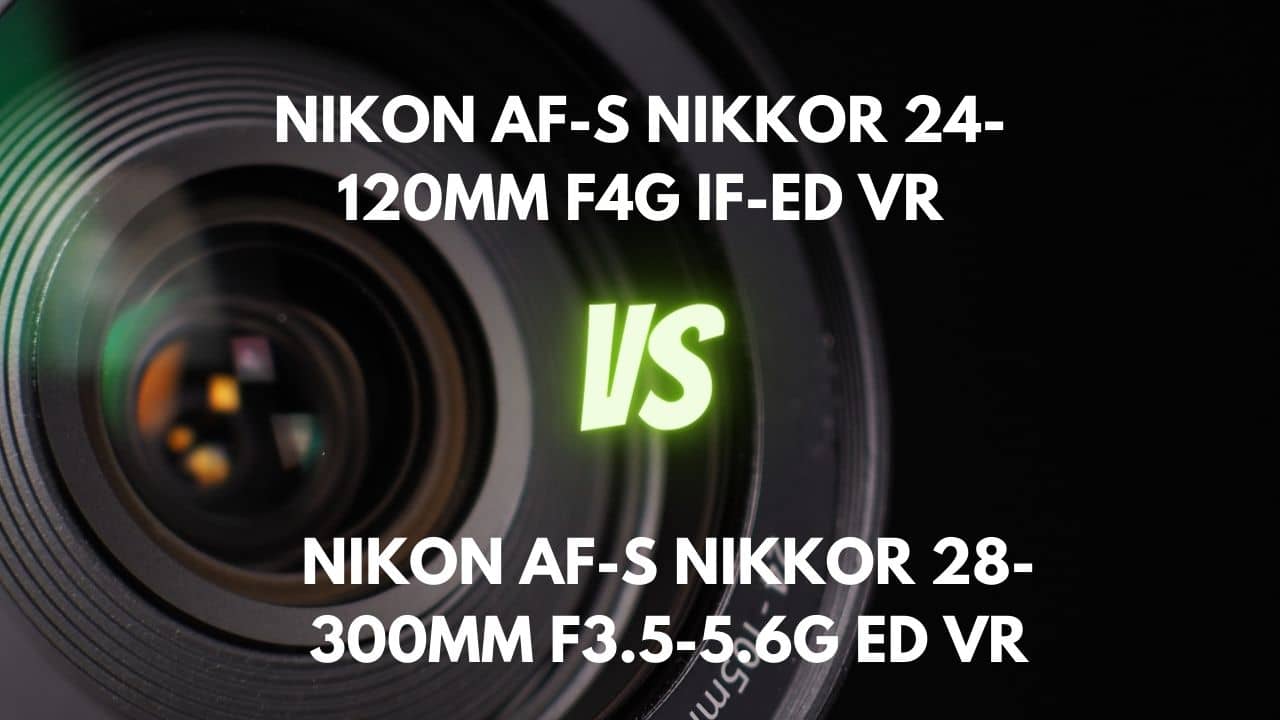Are you a passionate photographer searching for the perfect lens to elevate your art? Whether you’re capturing stunning landscapes, intimate portraits, or documenting life’s fleeting moments, choosing the right lens can make all the difference.
In the world of Nikon Z lenses, the 24-120mm f/4 and 24-70mm f/2.8 are two popular contenders that cater to diverse photography styles and requirements.
Our in-depth comparison of these two exceptional lenses will provide insights on their unique features, strengths, and weaknesses, guiding you to make an informed decision tailored to your creative pursuits.
By delving into critical aspects such as image quality, sharpness, bokeh, and more, we’ll help you uncover the lens that best resonates with your photography goals.
So, grab a cup of your favorite beverage and join us on this enlightening journey towards discovering the perfect companion for your camera.
Overview
| Nikon NIKKOR Z 24-120mm F4 S | Nikon NIKKOR Z 24-70mm F2.8 S | |
|---|---|---|
| Max Aperture | F4 | F2.8 |
| Aperture Type | Fixed | Fixed |
| Focal Range (mm) | 24-120 | 24-70 |
| Mount Type | Nikon Z | Nikon Z |
| Max Format | 35mm FF | 35mm FF |
| Zoom Ratio (X) | 5 | 2.9 |
The Nikon Z 24-120mm f/4 has a fixed maximum aperture of f/4 and a focal range of 24-120mm, offering a 5x zoom ratio. This lens has a versatile focal length range, making it suitable for various photography genres such as travel, events, or sports photography. However, its maximum aperture is smaller compared to the 24-70mm lens, which could impact low light performance and depth of field control.
On the other hand, the Nikon Z 24-70mm f/2.8 has a fixed maximum aperture of f/2.8, allowing more light to enter the camera and providing better low light performance and shallower depth of field for subject isolation. With a focal range of 24-70mm and a 2.9x zoom ratio, this lens offers less zoom flexibility than the 24-120mm lens but generally has better overall image quality, including sharpness, contrast, and reduced chromatic aberration.
In conclusion, if low light performance are your top priorities, the 24-70mm f/2.8 lens is the better choice. However, if you need a more versatile lens with a broader focal length range for various photography genres, the 24-120mm f/4 lens could be a more suitable option.
Design and Ease of Use
| Nikon NIKKOR Z 24-120mm F4 S | Nikon NIKKOR Z 24-70mm F2.8 S | |
|---|---|---|
| Diameter x Length (mm) | ⌀84×118mm | ⌀89×126mm |
| Weight (gr) | 630 | 805 |
| Filter Thread (mm) | 77 | 82 |
| Weather Sealing | Yes | Yes |
| Zoom Method | Rotary (extending) | Rotary (extending) |
| Distance Scale | No | No |
| DoF Scale | No | No |
| Hood Supplied | Yes | Yes |
| Hood Code | HB-102 | HB-87 |
The Nikon Z 24-120mm f/4 has a diameter of 84mm and a length of 118mm, with a weight of 630 grams. In contrast, the Nikon Z 24-70mm f/2.8 is slightly larger and heavier, with a diameter of 89mm, a length of 126mm, and a weight of 805 grams.
In terms of portability, the 24-120mm lens is more compact and lightweight, making it easier to carry around for extended periods. This can be particularly beneficial when traveling or walking around for long durations, as a lighter setup can help prevent fatigue and enable you to shoot for longer without feeling weighed down.
Regarding storage, the more compact 24-120mm lens takes up less space in your camera bag, leaving room for additional gear and making your bag lighter and easier to carry.
In conclusion, the 24-120mm lens is superior in terms of dimensions and weight, providing better portability, balance, discreetness, storage, and ease of lens swapping.
Lens Mount and Barrel
The Nikon Z 24-120mm f/4 features an aluminum lens mount with a rubber gasket for weather sealing, offering a sturdy connection while protecting the lens from dust and moisture. The lens barrel is made of a mix of anodized aluminum and primarily plastic components, finished in black plastic with rubber-covered sections for better grip. However, its dual telescoping barrel design, while precise, may be more vulnerable to damage in the long run compared to single extending barrels or internal zoom designs.
On the other hand, the Nikon Z 24-70mm f/2.8 has a metal lens mount, providing a robust and durable connection between the camera and the lens. The rubber gasket around the rear part of the lens ensures a protective barrier against dust and moisture. The lens barrel combines metal and plastic materials with metal trim, resulting in a strong and durable construction. The ergonomic bevel and rubberized surfaces on the zoom ring enhance comfort and grip. Its internal zoom mechanism maintains a consistent and compact form factor throughout the focal range.
In conclusion, the 24-70mm lens mount and barrel are superior due to their robust construction and internal zoom mechanism, which maintains a consistent form factor. While the 24-120mm lens also offers a sturdy lens mount and weather sealing, its lens barrel design might be more prone to damage over time.
Weather Sealing
The Nikon Z 24-120mm f/4 features weather sealing that includes a rubber gasket at the lens mount, internal seals at the rings, switches, and front of the barrel, as well as a fluorine coating on the front element to resist dirt and smudges. Although not completely dust and drip resistant under all conditions, it provides a good level of protection against dust and moisture and has been tested in harsh conditions, such as rainstorms. It’s advisable to wipe down the telescoping barrel before zooming back to 24mm when using it in challenging environments.
On the other hand, theNikon Z 24-70mm f/2.8 boasts comprehensive weather sealing to safeguard against dust and moisture, with seals at the lens mount, control rings, buttons, switches, and component joints. A rubber gasket at the rear part of the lens minimizes dust infiltration into the camera, while the front and rear lens elements feature fluorine coatings for moisture, fingerprint, and smudge resistance. This robust weather sealing makes the lens suitable for use in various challenging weather conditions, ensuring reliable performance and longevity.
In conclusion, the 24-70mm lens has a superior weather sealing design compared to the 24-120mm lens, offering more comprehensive protection against dust, moisture, and other environmental factors. This makes the 24-70mm lens a better choice for photographers who frequently shoot in harsh conditions or require a more rugged and durable lens.
Rings
The Nikon Z 24-120mm f/4 is equipped with three rings: focus, zoom, and control. Its manual focus control is positioned towards the front of the outer barrel, providing easy access. The zoom ring, while stiff, is not loose and displays marked focal lengths at 24, 28, 35, 50, 70, 85, and 120mm. The control ring, featuring a knurled texture, can be customized to modify aperture, exposure compensation, or ISO sensitivity, or even turned off.
Although the lens lacks an aperture ring, the control ring can be assigned this function. The rubberized focusing ring rotates smoothly and offers configurable linear or nonlinear response. These ridged and tactile rings contribute to the lens’s high-quality, sturdy feel, and balanced weight distribution. However, this lens does not have a windowed distance scale or depth-of-field indicator, which are minor drawbacks.
On the other hand, the Nikon Z 24-70mm f/2.8 also has three rings: a focus ring at the front, a zoom ring in the middle, and a customizable control ring near the rear. The focus ring is smooth and electronically coupled to the focus motor, allowing for speed-sensitive and precise adjustments. The rubberized zoom ring is firm and prevents accidental movement, covering the zoom range in a quarter-turn with consistent resistance.
The control ring can be assigned to manage aperture, ISO sensitivity, or exposure compensation, operating smoothly without a ‘clicky’ option. Although this lens does not have a windowed distance scale or depth-of-field indicator, it features a small OLED display on the barrel, showing focal length, focus distance, and aperture. The lens does not exhibit zoom creep and offers an extended zoom range from 24mm to 70mm. The manual focusing distance depends on the focus ring’s rotation speed, ranging from a quarter-turn to a half-turn.
In conclusion, both lenses have well-designed rings, offering good ergonomics, precision, control, and build quality. The 24-120mm lens provides more marked focal lengths and a slightly more versatile zoom range, while the 24-70mm lens boasts a small OLED display and electronically-coupled focus ring for precise adjustments.
Switches/Buttons
The Nikon Z 24-120mm f/4 is equipped with an AF/MF switch situated towards the rear, enabling users to swiftly and effortlessly switch between autofocus and manual focus. It also includes a customizable L-Fn (Lens-function) button that can execute various tasks such as AF-ON, metering settings, and subject tracking. The switch and button are typically easy to locate and use, with the L-Fn button featuring a rubberized surface for improved operation.
Conversely, the Nikon Z 24-70mm f/2.8 offers a single AF/MF slide switch for alternating between autofocus and manual focus modes. Additionally, it has a programmable L-fn (Lens Function) button, which can be assigned to different functions like autofocus lock, subject tracking, or image playback. The L-fn button is positioned next to the Display mode button, utilized for cycling through various OLED display modes such as focal length, aperture, or focus distance. The lens’s switches and buttons are designed for easy access and user-friendliness, allowing photographers to make rapid adjustments without navigating through the camera’s menu system.
In conclusion, both lenses provide user-friendly switches and buttons, enhancing their usability and functionality. The 24-120mm lens features a rubberized surface for its L-Fn button, while the 24-70mm lens offers a Display mode button for managing the OLED display modes. Ultimately, the 24-70mm lens takes the lead in terms of switches/buttons due to the added Display mode button, making it a more convenient option for photographers who require quick access to various functions without delving into the camera’s menu.
Filter Thread
The Nikon Z 24-120mm f/4 features a plastic 77mm filter thread, which does not rotate during focusing. This lens is compatible with various filters, including standard rotating polarizers or grad filters at 24mm, without causing vignetting on full-frame cameras. However, the filter ring is also made of plastic, so users should be cautious when mounting screw-on filters to prevent damage.
In contrast, the Nikon Z 24-70mm f/2.8 comes with an 82mm filter thread, a common size for high-performance 24-70mm f/2.8 lenses. The front element and filter thread remain stationary during focusing, ensuring convenience when using filters. Although attaching and detaching filters is relatively simple, rotating polarizing filters can be challenging when the lens hood is mounted. The petal-shaped plastic hood features a locking mechanism to prevent accidental detachment, enhancing ease of use with filters.
In conclusion, both lenses offer filter threads that allow for easy filter usage without rotating during focus. The 24-120mm lens has a smaller, 77mm filter thread, while the 24-70mm lens has a larger, 82mm thread, providing better compatibility with high-performance lenses. Despite the 24-120mm lens being compatible with a wider range of filters, the 24-70mm lens is superior in terms of filter thread due to its larger size and commonality among professional lenses, making it a more practical choice for photographers who prioritize performance and compatibility.
Lens Hood
The Nikon Z 24-120mm f/4 comes with a petal-shaped lens hood made of plastic, which is included in the package. This hood features a reversible design that allows for easy storage. Although the finish might feel flimsy, it can be smoothly attached to the lens.
On the other hand, the Nikon Z 24-70mm f/2.8 also includes a plastic lens hood in the package. This hood has a black velvet-like interior coating that reduces reflections, thus preventing unwanted flare when shooting in bright light. The ergonomic bevel of the hood enables quick attachment and detachment, while its reversible design ensures convenient storage and transport. Although the hood does not have a locking mechanism, it is still easy to mount and rotate smoothly.
Focusing and Optical Stabilization
| Nikon NIKKOR Z 24-120mm F4 S | Nikon NIKKOR Z 24-70mm F2.8 S | |
|---|---|---|
| Autofocus | Yes | Yes |
| AF Motor | Stepper motor | Stepper motor |
| Rotating Front Element | Does not rotate on focusing | Does not rotate on focusing |
| Min Focus Distance | 0.35m | 0.38m |
| Max Magnification (X) | 0.39 | 0.22 |
| Full-Time Manual Focus | Yes | Yes |
| Focus Method | Internal | Internal |
Focusing Performance
The Nikon Z 24-120mm f/4 offers fast and accurate autofocus performance, with virtually silent operation suitable for both stills and video. The focusing speed is remarkable, taking around 0.35 seconds to focus from infinity to 1.28m at 120mm focal length. It performs well in low-light situations and features eye-tracking capabilities.
The autofocus system includes a manual focus override, allowing users to fine-tune focus using the electronic focus ring. The lens has an internally focusing design, ensuring a constant length and a non-rotating front element. Focus breathing is minimal, making it ideal for videography.
In contrast, the Nikon Z 24-70mm f/2.8 demonstrates excellent autofocus performance with minimal noise. Its focusing speed is moderate, taking around 0.5 seconds to focus from infinity to 0.77m at a 70mm focal length. It also performs well in low-light situations, with any hesitancy attributed to the camera’s AF rather than the lens itself.
The lens features manual focus override and a smooth manual focus action. The internally focusing design keeps the length constant and prevents the front element from rotating during focusing. It also minimizes focus breathing, which is advantageous for video shooting or focus stacking.
Optical Stabilization
The Nikon Z 24-120mm f/4 does not feature optical image stabilization but is compatible with in-camera stabilization on Nikon Z full-frame cameras, providing up to 4 stops of stabilization. This level of stabilization is suitable for various shooting situations, including low-light conditions and handheld shooting.
On the other hand, the Nikon Z 24-70mm f/2.8 also lacks optical image stabilization but relies on the Nikon Z body’s built-in sensor-shift stabilization, offering up to 5-axis stabilization. This stabilization is generally silent and effective, providing a real-world improvement of 3 to 4 stops. This allows for sharp, hand-held shots at slower shutter speeds than without stabilization, with performance being excellent throughout the lens’s range.
Image Quality
| Nikon NIKKOR Z 24-120mm F4 S | Nikon NIKKOR Z 24-70mm F2.8 S | |
|---|---|---|
| Special Elements | 3 ED elements, 3 aspherical elements, 1 aspherical extra-low dispersion | 4 ED and 2 aspherical elements + Arneo and Nano Crystal coatings |
| Diaphragm Blades | 9 | 9 |
Aberration
The Nikon Z 24-120mm f/4 demonstrates good control over chromatic aberration, exhibiting only mild lateral and longitudinal chromatic aberration under specific conditions. Spherochromatism or axial color is not noticeable, and the lens effectively suppresses false color, contributing to the overall image quality.
In contrast, the Nikon Z 24-70mm f/2.8 showcases excellent control over chromatic aberration. Longitudinal chromatic aberration is minimal and can be easily managed in post-processing, while lateral chromatic aberration is well-controlled and rarely impacts image quality. Software like Lightroom can automatically correct any aberration present. Additionally, coma is well-managed, and spherical aberration or spherochromatism is almost non-existent, making this lens an ideal choice for producing smooth, out-of-focus backgrounds without unwanted color fringes.
In conclusion, the 24-70mm lens outperforms the 24-120mm lens in terms of aberration control, delivering impressive performance across various aberrations and contributing to superior overall image quality.
Sharpness
The Nikon Z 24-120mm f/4 showcases exceptional sharpness throughout its focal length range, with outstanding center sharpness. Although corner sharpness is generally impressive, it may be slightly less sharp than the center. Optimal results are obtained from f/5.6 to f/16, while the sharpest apertures usually range from f/4 to f/8, depending on the focal length. However, diffraction starts to impact sharpness at smaller apertures like f/16 and f/22.
On the other hand, the Nikon Z 24-70mm f/2.8 delivers impressive sharpness across its aperture range, with remarkable center sharpness. The lens performs very well at wider apertures like f/2.8, reaching peak performance at f/5.6 for most focal lengths. Corner sharpness typically improves when stopped down to f/5.6 or f/8, with the sharpest apertures falling between f/5.6 and f/8, depending on the focal length. At smaller apertures like f/16 and f/22, there is a slight decline in sharpness due to diffraction effects.
In conclusion, both lenses exhibit excellent sharpness performance. However, the 24-70mm lens maintains superior sharpness throughout its aperture range, making it the better choice for capturing images with consistently high sharpness across various shooting scenarios.
Bokeh Quality
The Nikon Z 24-120mm f/4 produces a bokeh that is of variable quality, depending on the focal length and aperture settings. At wider apertures and longer focal lengths, the bokeh appears fairly smooth and pleasing, with good subject separation. However, the lens may exhibit some onion skin effects in specular highlights and soap bubble bokeh in certain situations. Furthermore, the bokeh may appear less smooth or creamy when shooting at shorter focal lengths or smaller apertures.
On the other hand, the Nikon Z 24-70mm f/2.8 generates a generally pleasing bokeh, characterized by smooth, creamy, and blurred backgrounds, making it suitable for various subjects like portraiture and still life. However, it may exhibit some issues such as busy bokeh in slightly defocused regions or transition zones, occasional cat-eye patterns in busy backgrounds, and visible outlines inside background highlights. While the bokeh is mostly satisfactory, if you’re seeking a lens specifically for creamy bokeh, you might consider other options like the Nikon 85mm f/1.4G, which is optimized for beautiful out-of-focus highlights.
In conclusion, both lenses offer decent bokeh quality, but the 24-70mm lens delivers a generally smoother and creamier bokeh, making it the superior choice for capturing images with pleasing out-of-focus backgrounds.
Flare/Ghosting
The Nikon Z 24-120mm f/4 demonstrates good resistance against flare and ghosting, particularly on the short end. The coatings applied to the front glass further enhance its resistance to these artifacts, making it a great lens for shooting in high dynamic range scenes or towards bright points of light.
In comparison, the Nikon Z 24-70mm f/2.8 exhibits exceptional performance when it comes to controlling flare and ghosting. The integration of Nikon’s ARNEO coat and Nano Crystal Coat significantly reduces ghosting and flare, even when shooting bright sources of light. As a result, you will rarely encounter these issues in your images.
Additionally, the lens exhibits minimal veiling glare and maintains deep blacks. However, some flare and ghosting might be noticeable at the corners in specific situations, such as when the light source is just outside the corner at 24mm or 70mm focal lengths.
In conclusion, both lenses show good resistance to flare and ghosting, but the 24-70mm lens outperforms the 24-120mm lens in this aspect due to its advanced coatings and overall exceptional performance.
Vignetting
The Nikon Z 24-120mm f/4 shows some vignetting, especially at wider apertures like f/4, but it is not highly noticeable and can be easily corrected in post-processing or with in-camera corrections. As you move to longer focal lengths, vignetting becomes less prominent.
On the other hand, the Nikon Z 24-70mm f/2.8 displays moderate vignetting, more pronounced at wide focal lengths. While it outperforms the Nikon 24-70mm f/2.8E ED VR in this regard, it falls short when compared to the Nikon 24-70mm f/2.8G, which has minimal vignetting past f/4. However, similar to the 24-120mm lens, vignetting is not a major concern, as post-processing tools can effectively correct it.
In conclusion, neither lens exhibits a significant advantage in terms of vignetting. Both lenses perform adequately, and any vignetting can be easily managed through in-camera corrections or post-processing adjustments.
Distortion
The Nikon Z 24-120mm f/4 displays some distortion, particularly at wider focal lengths, where barrel distortion becomes evident. However, Nikon’s automatic distortion correction profiles, along with post-processing software like Lightroom and Photoshop, can effectively minimize this issue.
In contrast, the Nikon Z 24-70mm f/2.8 exhibits noticeable barrel distortion at 24mm but is less prominent than in the Nikon 24-70mm f/2.8G and 24-70mm f/2.8E VR lenses. The distortion shifts to mild pincushion distortion as you zoom in towards 35mm and increases to around 3% at 70mm. Like the 24-120mm lens, distortion can be effectively addressed through in-camera features and post-processing software.
In summary, both lenses exhibit some degree of distortion, but the 24-70mm lens has a slight advantage with less prominent distortion throughout the zoom range. Nonetheless, distortion in both lenses can be effectively managed with available tools, making them suitable for various photography applications.
Final Verdict
After considering all aspects of the Nikon Z 24-120mm f/4 and Nikon Z 24-70mm f/2.8, the final verdict is as follows:
For travel, landscape, and everyday photography, the 24-120mm lens is the better choice due to its broader focal length range, lighter weight, and compact size. Its versatility makes it suitable for various photography genres and situations, while its manageable distortion and vignetting issues can be addressed with available tools.
On the other hand, the 24-70mm lens excels in portraiture, low light situations, and professional applications, as it offers superior sharpness, bokeh, aberration control, weather sealing, and flare/ghosting resistance. Its robust construction and internal zoom mechanism make it ideal for photographers who frequently shoot in harsh conditions or require a more rugged and durable lens.

